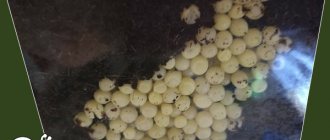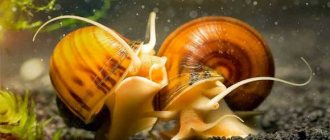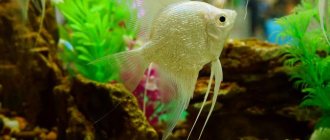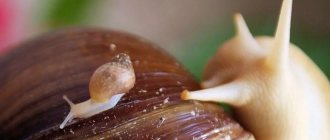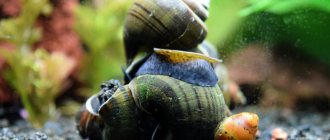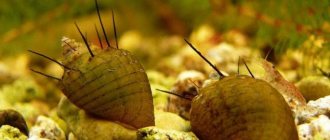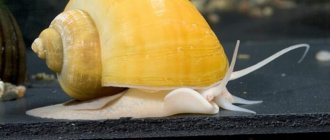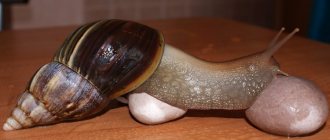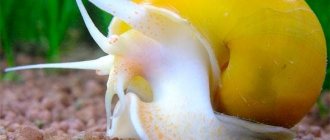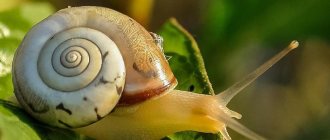Several years ago, a new gastronomic product appeared on the world market - snail caviar. Snail caviar quickly gained a leading place on the exquisite tables of Parisian and London gourmets. But the inhabitants of Ancient Egypt and Rome ate it as an aphrodisiac; they claimed that snail caviar made them tireless lovers.
Snail caviar resembles small white pearls, with the taste and smell of noble mushrooms. According to connoisseurs of everything unusual, after tasting snail caviar, they seemed to feel the fresh aroma of the autumn forest or the smell of oak leaves and forest moss. That's why they call it forest pearls. Most often, white caviar is served on toast with martini or champagne. It is also used to prepare exotic sauces and dishes.
People often ask on the Internet whether it is possible to eat Achatina meat and eggs or how to prepare African snail caviar. Yes, just like grape snail caviar. Achatina caviar is in no way inferior to grape caviar. It contains a lot of vitamins and microelements beneficial for our body. Therefore, if you systematically freeze and destroy the clutch of Achatina, I suggest preparing you an expensive dish - white snail caviar.
The legend of the origin of the delicacy
There are many legends about how this delicacy was discovered, and we will tell you one of them. One day, an ordinary mechanic who worked in a French restaurant located in the basement of an old house (and in France this is a common thing) encountered snails - the relationship did not work out, conflicts arose. The small courtyard area of the restaurant became the scene of hostilities: snails often attacked the mechanic’s property, left slippery marks on tools and equipment, and scattered traces of vital activity in the most unexpected places. The fighting took a serious turn, and in order to put an end to all this slippery tribe at once, the mechanic couldn’t think of anything better than to eat their caviar. This stopped the fighting, and the taste of victory turned out to be very pleasant. The mechanic decided to share his discovery with the restaurant's chef, who was delighted with the new taste. So an ordinary mechanic decided to open the first snail farm just for breeding caviar and began supplying caviar to restaurants in France.
Snail farms
There are snail farms where mollusks are provided with a special temperature regime and lighting that encourages their desire to lay eggs. Not all snail farms are focused on obtaining the maximum amount of caviar. Therefore, the price of grape snail caviar is much higher than the cost of the mollusks themselves.
Obtaining snail eggs is possible only under certain conditions. At the same time, selecting, sorting and washing shellfish eggs from soil residues is a complex process that requires certain costs. On some farms they are kept in special containers with sandy soil, in the thickness of which the mollusks lay eggs.
The yield of the finished product, in comparison with fish caviar, is scanty. To imagine this difference, you should understand that one individual grape snail can lay only 4 g of eggs. And to obtain 1 kg of product, farm employees manually process about 250 clutches.
Snail caviar calorie content and benefits
Snail caviar has established itself in Europe as a healthy delicacy that surpasses the healthfulness of fish and has low calorie content. This dish is a godsend for you if you are watching your health and weight. 100 grams of caviar contain only 90 kcal , but as much as 16 g of protein and only 1.4 g of fat. For comparison, red salmon caviar contains 252 kcal, 32 g of protein and 15 g of fat. The content of Omega-3 fatty acids, calcium, magnesium, iron, vitamins A, E, K, B12 and other microelements play an important role in strengthening the immune system. Speaking about the benefits of snail caviar, let's add a piquant detail: snail caviar is a natural aphrodisiac.
Sexual dimorphism
Ampularia are heterosexual, and to obtain offspring you need to have a male and a female. Sexual dimorphism is not expressed. Only the snails themselves can distinguish males from females. Even if you look under the cap, it is unlikely that you will be able to determine the gender. The only way to determine the sex of a snail is to watch the snails as they mate. The male is always on top.
There is no sexual dimorphism in ampullaria, however, by following the pair during mating, you can track the male individual.
In captivity there are a large number of subspecies that can even reproduce in their own way. All these mollusks are called ampullaria. The most popular are yellow ampullaria, which are actually albinos. The usual ampularia lays eggs above the water level, in a dry place.
In order to be guaranteed to obtain offspring, you should purchase at least 4-6 copies. Among such a number of snails, there is guaranteed to be at least one pair consisting of a female and a male. If there are ampullaria of different sexes in the reservoir, reproduction will not cause big problems.
Snail caviar in nature
Not every snail's caviar is suitable for food; the most delicious caviar is produced by snails of the Helix Aspersa . Interestingly, snails choose their own sex before breeding. This advantage makes it possible for snails to survive in the wild, since snails have many enemies, but few ways to protect themselves from them, even their house is a poor shelter. In European countries there are quotas for collecting wild snails; those who want to enjoy a variety of snail dishes have more opportunities for its reproduction.
LiveInternetLiveInternet
—Categories
- SNAILS and my other little animals (11)
- 3D Models free (1)
- ANTIQUES (23)
- ARCHEOLOGY, ANTIQUITS (103)
- QUESTION AND ANSWER (134)
- CHILDREN (431)
- Closed section (33)
- ART (903)
- HISTORICAL COSTUMES, JEWELRY (93)
- HISTORY, new chronology (3516)
- Cooking (633)
- Magical practices (4783)
- PLACES OF POWER, SHAMANS, STONES (25)
- SCIENCE (136)
- OUR DACHA, Landscape (255)
- NECROPACTICS, GOOD DEEDS (25)
- WEAPONS, BUNKER (181)
- Useful little things (781)
- Travel, Nature (491)
- We draw ourselves (71)
- DIY (191)
- TALES, MYTHS (284)
- SPORTS NOSTALGIE (26)
- USSR, SING, REVOLUTION! (186)
- TAROT (34)
- FOR STUDENTS ONLY (449)
- DESIGN LESSONS (97)
- Healing (1197)
- Esoteric shop (1)
—Quote book
Library: Amis Lee Series: “Drawing 50.” Amis Lee Series: “Drawing 50.”
There is a cliff on the Volga. Russian Marseillaise Song “There is a cliff on the Volga...”.
Snail caviar production
The Mediterranean snail lays about 3 grams of eggs each and can be harvested twice a year. Snail eggs are collected by hand, each egg is examined under a microscope and damaged eggs are removed. Then they are washed, sorted again and salted with spices and truffle juice. To prevent the proliferation of microorganisms and preserve vitamins, snail caviar is packaged in jars under vacuum. It is precisely because of the labor-intensive process of collecting, processing, salting caviar and its small quantities that snail caviar is one of the most expensive delicacies. In Europe, the cost of snail caviar is estimated at 300 euros for 100g.
Description
Snail egg caviar is a delicious product that consists of fresh or processed eggs of a land mollusk. Many English-language sources call this product quite elegantly: “Aphrodite’s pearls.” This is due to the content of certain substances in it that increase attraction to the opposite sex. They are called aphrodisiacs in honor of the Greek goddess of love.
What does snail eggs look like? Unprocessed shellfish eggs are colorless, translucent eggs with a diameter of about 3 - 4 mm, and sometimes 5 - 6 mm.
After treatment, the color may change to white, beige or pinkish.
Nowadays, many snail farms have been created where edible shellfish are grown en masse. Some of them collect caviar, which is then sold. For example, in 2014 for 50 grams. This delicacy product in Europe was asked for 150 euros. This is considered an expensive pleasure even for prosperous France.
Untreated snail eggs are covered with a smooth, fragile shell that becomes stronger when exposed to high temperatures. When pasteurization occurs, eggs partially lose their taste and beneficial properties. Therefore, many people prefer to pickle them. To do this, the product is first soaked in a special brine and then preserved. The additives that manufacturers use to prepare brine are completely different. Therefore, the taste and aroma of the finished product may differ depending on the recipe.
How is caviar served?
Snail caviar is good on its own, but gourmets say that caviar adds a delicate and unique taste to any dish! The special taste of caviar will highlight the taste of dishes with snail caviar - salads, appetizers, main courses, but to truly taste the taste of snail caviar, you can spread the caviar on crispy toast with butter. Well, to fully enjoy the taste of caviar, you can simply put the caviar on your tongue. You may not become a fan of dishes with snail caviar, but you should definitely try it! New tastes allow you to fill yourself with unusual impressions, help you cope with the autumn blues and let new feelings into your life.
Taste qualities
There are a great many ways to prepare snail caviar. This is precisely what prevents us from having a unified idea of its taste. To some, it resembles baked asparagus, while others compare this product to baked mushrooms. Many have woody notes. At the same time, there is an “earthy aroma” and a similarity to sturgeon caviar.
Recipes for preparing snail caviar are very diverse, so there is no single way to use it. Usually this product is eaten with a piece of black bread, just like the grape snails themselves. Snail eggs are served with truffles and sage leaves. And among alcoholic drinks, sparkling wines are more suitable for them.
Snail caviar can also be included in other dishes, for example, various soups and salads.
Young ampullaria
In a common pond, young snails become food for fish, crawl into the filter or crevices between stones, and die. In order to preserve as many young animals as possible, they are placed in a separate pond and raised.
The ampularia eggs have hatched and you can already see the tiny snails.
The birth of babies occurs simultaneously. The eggs begin to burst, and then the clutch begins to crumble. Almost instantly, several hundred tiny snails appear in the water and on the walls of the aquarium. After birth, all ampullaria are hidden in the water.
Fish pellets are used as food. Snails feed on what is located at the bottom of the reservoir. The food is ground to a fine powder and poured onto the bottom. You can also give chopped duckweed, lettuce leaves, and riccia. Young ampullaria are not prone to overeating, and there is no need to be afraid of overfeeding. The bottom of the fish tank should always be clean, without sand or gravel. This way the kids will find food faster.
Conditions for raising young animals
- Snails need ventilation at least twice a day, for a quarter of an hour. Also, once every three days it is necessary to replace a third of the water.
- In the first 7-8 days, approximately half of newborn babies die. Thanks to natural selection, the healthiest and most viable remain.
- The speed of development of ampullaria is not the same. Individuals from the same clutch develop differently. For this reason, snails will not enter a common body of water at the same time, but only after they have reached large sizes. The largest ones are removed first, and the smaller ones are left to gain weight.
- If cracks appear on the surface of the shell, then the water in which the snails are kept is too soft. To solve the problem, just dilute ordinary table salt in water. For a volume of 50 liters, a level tablespoon is enough. You can also add minerals. All holes in the shells will disappear.
- Mollusks are prone to regeneration. Even if a fish tore off an eye or another part of the body from an ampoule, it will grow back in about a month. The new organ will be smaller in size, but this will not affect functionality.
It is very important to constantly check the pond for dead snails or empty shells. All this must be removed, since decay products poison the water and lead to the death of healthy individuals.
There is a joke among aquarists that it takes more effort to stop snails from breeding than to start it!
Breeding ampullaria snails is not particularly difficult. It is enough to purchase several copies and create favorable conditions. Sexual maturity occurs at the age of one year, and ampularia live up to 4 years.
What to do with extra snails
To remove excess shellfish from an aquarium, the following methods are used:
- Use chemicals from a pet store and add them to the aquarium water according to the instructions.
- Electric current is applied. This method of regulating the number of mollusks is only for experienced aquarists.
- Adults and eggs are caught by hand.
- They breed mollusks that do not reproduce in fresh water.
- They breed a predatory helena, which produces small offspring and devours other mollusks.
Reproduction of snails, which perform an important role as cleaners in a community aquarium, is not difficult. The aquarist only needs to control the number of individuals and prevent overpopulation.
How do Achatina reproduce?
African Achatina are large land mollusks, with high-quality care and maintenance, reaching up to 30 cm in diameter, weighing up to 500 g. Sexual maturity occurs at one year of age. Egg laying occurs every 2 months.
Achatina is a unisexual species, although its representatives are not prone to self-fertilization. More often, individuals fertilize each other. Moreover, they do not have female and male reproductive organs; instead, calcareous formations come out of the front part of the body. The function of the female, that is, the carrier of eggs, is taken over by a larger individual whose body is stronger. Sperm in the Achatina body is stored in a viable state for up to 2 years.
How do snails reproduce in an aquarium?
- Pregnancy lasts 2 weeks.
- Then the pregnant female lays about 200 eggs for further 2-3 weeks of gestation.
- Eggs have a hard shell. As the embryos develop, it becomes thinner and releases minerals to the developing shell.
- When the shell becomes very thin, the snail breaks it and is released.
Feeding of young animals is the same as for adult mollusks. But the food needs to be crushed.

